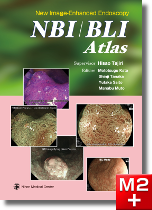- m3.com 電子書籍
- New Image-Enhanced Endoscopy NBI/BLI Atlas

New Image-Enhanced Endoscopy NBI/BLI Atlas
Hisao Tajiri (Supervisor) / Mototsugu Kato , Shinji Tanaka , Yutaka Saito , Manabu Muto (Editors) / 日本メディカルセンター
商品情報
内容
序文
Preface
The history of endoscopy over the past three decades has been marked by steady and rapid progress in endoscopic treatment, as arisen from the development of the video endoscope in 1983, leading to rapid advances in the subsequent years. The 1980s were characterized by improvements in endoscopic treatment of early gastrointestinal cancers using EMR, while in the 1990s, previous concepts of diagnosis and treatment of gastric diseases were overturned when the association between H. pylori and diseases of the gastrointestinal tract was verified. In the 2000s, the rapid dissemination of ESD has led to further advances in endoscopic treatment, while the introduction of the HDTV endoscope to the market in 2002, together with more recent innovations such as image-enhanced endoscopy (IEE) and magnifying endoscopy, has provided the basis for new diagnostic study. Now, thanks to the introduction of high-resolution endoscopes and magnifying endoscopes with NBI (Narrow Band Imaging), which provide clear and accurate observation of the microstructures and microvascular architectures on the mucosal surfaces, the grade of tissue atypism can be estimated with endoscopy. Soon we will enter a new era of endoscopic diagnosis, an era of what we can call "endoscopic pathology" in pretherapeutic examinations.
These minute diagnostics have triggered a quantum leap in traditional endoscopic diagnosis. Supported by the achievements of prospective multicenter studies, these developments have had a profound impact on gastrointestinal endoscopists and cancer researchers around the world. As a result, it has been propagated worldwide and made a significant contribution to actual cancer treatments, as well as to clinical studies.
Since the summer of 2012, two systems have been released which are designed to obtain images with even higher definition easily than before. They are the EVIS LUCERA ELITE system with built-in NBI from Olympus Medical Systems Corporation and the LASEREO laser endoscopy system from Fujifilm Corporation featuring another new method called BLI (Blue Laser Imaging).This book was written in order to give you an idea of what the endoscopic images obtained with the new systems look like, explain how to incorporate IEE in endoscopic diagnosis and provide tips on observation using the new IEE techniques. Drawing on a comprehensive collection of case images as ATLAS sourced from hospitals that have already introduced these new systems, this book will guide you step by step through the diagnostic process, enabling you to observe minute changes in the endoscopic images and compare those observations with the explanations given by the authors. We are confident that this book will serve as a leading reference with high quality for a wide range of people, from young physicians aiming at becoming endoscopy specialists to doctors who are already acting as specialists or trainers, providing them with the knowledge they need to understand the new image-enhanced endoscopy and the guidance they need to take advantage of.
We hope that the material included in this book will give our readers the confidence to take on the challenge of pioneering the use of second-generation NBI, which has surmounted the problems associated with conventional NBI and/or BLI in routine procedures, and to perform evaluations and studies in order to establish more sophisticated diagnostics and advance new functional studies.
Finally, we would like to express our gratitude to the many doctors who contributed to this book even though they were very busy. We would also like to express gratitude to Ms. Setsuko Kurozoe at Nihon Medical Center for her work in the editing of this book.
October 2013
Hisao Tajiri
President, Japan Gastroenterological Endoscopy Society
Professor, Department of Gastroenterology and Hepatology/
Department of Endoscopy, The Jikei University School of Medicine, Tokyo, Japan
目次
Principles of NBI and BLI
NBI (Narrow Band Imaging)
BLI (Blue Laser Imaging)
Oropharynx and Hypopharynx
General Theory:How to Observe These Regions with NBI or BLI
Tips on NBI Observation
Tips on BLI Observation
Case Atlas
Case 1 NBI Inflammatory pharyngeal lesion
Case 2 BLI Hypopharyngeal papilloma
Case 3 NBI Pharyngeal melanosis
Case 4 BLI Pharyngeal melanosis
Case 5 NBI Oropharyngeal superficial carcinoma (0-IIa)
Case 6 BLI Oropharyngeal superficial carcinoma (0-IIb)
Case 7 NBI Hypopharyngeal superficial carcinoma (0-IIb)
Case 8 BLI Hypopharyngeal superficial carcinoma (0-IIa+IIb)
Esophagus
General Theory:How to Observe These Regions with NBI or BLI
Tips on NBI Observation
Tips on BLI Observation
Case Atlas
Case 9 NBI Glycogenic acanthosis(GA)
Case 10 BLI Esophageal papilloma
Case 11 NBI NERD
Case 12 BLI NERD
Case 13 NBI GERD
Case 14 BLI GERD
Case 15 NBI Type 0-I superficial esophageal carcinoma
Case 16 BLI Type 0-Is superficial esophageal carcinoma
Case 17 BLI Type 0-IIa superficial esophageal carcinoma
Case 18 BLI Type 0-IIb superficial esophageal carcinoma
Case 19 NBI/BLI Type 0-IIc superficial esophageal cancer
Case 20 NB/BLI Type 0-IIc superficial esophageal cancer
Case 21 BLI Type 0-IIc superficial esophageal carcinoma
Case 22 NBI Barrett's esophagus
Case 23 BLI Barrett's esophagus
Case 24 NBI Barrett's esophageal adenocarcinoma
Case 25 BLI Barrett's esophageal adenocarcinoma
Stomach and Duodenum
General Theory:How to Observe These Regions with NBI or BLI
Tips on NBI Observation
Tips on BLI Observation
Case Atlas
Stomach
Case 26 NBI Chronic gastritis
Case 27 BLI Chronic gastritis
Case 28 NBI Gastric adenoma
Case 29 BLI Gastric adenoma
Case 30 NBI Differential diagnosis of adenoma and gastric carcinoma
Case 31 BLI Differential diagnosis of erosion and early gastric carcinoma
Case 32 NBI Diagnosis of extent of early gastric cancer
Case 33 BLI Diagnosis of extent of early gastric carcinoma
Case 34 BLI Diagnosis of extent of early gastric carcinoma
Case 35 NBI Type 0-IIc differentiated early gastric carcinoma
Case 36 NBI Diagnosis of histological type of early gastric carcinoma
Case 37 BLI Diagnosis of histological type of early gastric carcinoma
Case 38 BLI Diagnosis of histological type of early gastric carcinoma
Case 39 NBI Transnasal endoscopic observation of early gastric carcinoma
Case 40 NBI Early carcinoma in gastric remnant
Case 41 NBI MALT lymphoma
Case 42 BLI MALT lymphoma
Duodenum
Case 43 NBI Duodenal adenoma
Case 44 BLI Duodenal adenoma
Case 45 NBI Duodenal carcinoma
Case 46 BLI Duodenal carcinoma
Case 47 BLI Duodenal carcinoma
Featured Article
Pathological correlative approach to magnified images
Colon and Rectum
General Theory:How to Observe These Regions with NBI or BLI
NBI Observation―Basic Principles and Operation Tips
Tips on BLI Observation
Case Atlas
Case 48 NBI Hyperplastic polyp
Case 49 NBI SSA/P (sessile serrated adenoma/polyp)
Case 50 BLI SSA/P (sessile serrated adenoma/polyp)
Case 51 BLI SSA/P (sessile serrated adenoma/polyp)
Case 52 NBI Protruding serrated adenoma
Case 53 NBI Elevated tubular adenoma
Case 54 NBI Superficial tubular adenoma
Case 55 NBI Tubulovillous adenoma
Case 56 BLI Villous adenoma
Case 57 NBI Protruding M carcinoma
Case 58 NBI Slightly elevated M carcinoma
Case 59 NBI Slightly depressed M carcinoma
Case 60 NBI Elevated SM carcinoma
Case NBI Slightly depressed SM carcinoma
Case 62 BLI Composite (IIa+IIc) SM carcinoma
Case 63 BLI Composite (IIa+IIc) SM carcinoma
Case 64 NBI Composite (IIa+IIc) SM carcinoma
Case 65 NBI Composite (Is+IIc) SM carcinoma
Case 66 NBI LST-G, homogeneous type
Case 67 BLI LST-G, nodular mixed type
Case 68 NBI LST-NG, pseudo-depressed type
Case 69 BLI LST-NG, pseudo-depressed type
Case 70 NBI/BLI LST-NG, pseudo-depressed type
Case 71 NBI LST-NG, pseudo-depressed type
Case 72 BLI LST-NG, pseudo-depressed type
Case 73 BLI Ulcerative colitis
Case 74 NBI Tumor associated with inflammatory colon diseases(carcinoma/dysplasia)
Featured Articles
Magnifications in Near Focus electronic zoom observation of the LUCERA ELITE system
Importance of structure enhancement in NBI magnifying observation
便利機能
- 対応
- 一部対応
- 未対応
-
全文・
串刺検索 -
目次・
索引リンク - PCブラウザ閲覧
- メモ・付箋
-
PubMed
リンク - 動画再生
- 音声再生
- 今日の治療薬リンク
- イヤーノートリンク
-
南山堂医学
大辞典
リンク
- 対応
- 一部対応
- 未対応
対応機種
iOS 最新バージョンのOSをご利用ください
外部メモリ:215.5MB以上(インストール時:468.6MB以上)
ダウンロード時に必要なメモリ:862.0MB以上
AndroidOS 最新バージョンのOSをご利用ください
外部メモリ:74.2MB以上(インストール時:185.5MB以上)
ダウンロード時に必要なメモリ:296.8MB以上
- コンテンツのインストールにあたり、無線LANへの接続環境が必要です(3G回線によるインストールも可能ですが、データ量の多い通信のため、通信料が高額となりますので、無線LANを推奨しております)。
- コンテンツの使用にあたり、m3.com電子書籍アプリが必要です。 導入方法の詳細はこちら
- Appleロゴは、Apple Inc.の商標です。
- Androidロゴは Google LLC の商標です。
書籍情報
- ISBN:9784888759021
- ページ数:236頁
- 書籍発行日:2014年11月
- 電子版発売日:2018年11月16日
- 判:B5判
- 種別:eBook版 → 詳細はこちら
- 同時利用可能端末数:2
お客様の声
まだ投稿されていません
特記事項
※今日リンク、YNリンク、南山リンクについて、AndroidOSは今後一部製品から順次対応予定です。製品毎の対応/非対応は上の「便利機能」のアイコンをご確認下さいませ。
※ご入金確認後、メールにてご案内するダウンロード方法によりダウンロードしていただくとご使用いただけます。
※コンテンツの使用にあたり、m3.com 電子書籍(iOS/iPhoneOS/AndroidOS)が必要です。
※書籍の体裁そのままで表示しますため、ディスプレイサイズが7インチ以上の端末でのご使用を推奨します。




